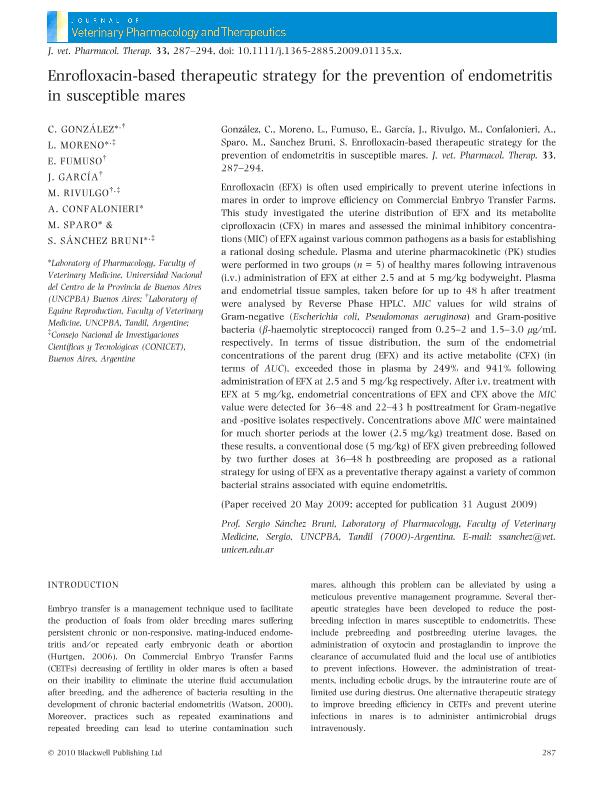Artículo
Enrofloxacin-based therapeutic strategy for the prevention of endometritis in susceptible mares
González, C.; Moreno, Laura Susana ; Fumuso, Elida Ana; García, J.; Rivulgo, Virginia Margarita
; Fumuso, Elida Ana; García, J.; Rivulgo, Virginia Margarita ; Confalonieri, Alejandra
; Confalonieri, Alejandra ; Sparo, Mónica Delfina; Sanchez Bruni, Sergio Fabian
; Sparo, Mónica Delfina; Sanchez Bruni, Sergio Fabian
 ; Fumuso, Elida Ana; García, J.; Rivulgo, Virginia Margarita
; Fumuso, Elida Ana; García, J.; Rivulgo, Virginia Margarita ; Confalonieri, Alejandra
; Confalonieri, Alejandra ; Sparo, Mónica Delfina; Sanchez Bruni, Sergio Fabian
; Sparo, Mónica Delfina; Sanchez Bruni, Sergio Fabian
Fecha de publicación:
06/2010
Editorial:
Wiley Blackwell Publishing, Inc
Revista:
Journal of Veterinary Pharmacology and Therapeutics
ISSN:
0140-7783
Idioma:
Inglés
Tipo de recurso:
Artículo publicado
Clasificación temática:
Resumen
Enrofloxacin (EFX) is often used empirically to prevent uterine infections in mares in order to improve efficiency on Commercial Embryo Transfer Farms. This study investigated the uterine distribution of EFX and its metabolite ciprofloxacin (CFX) in mares and assessed the minimal inhibitory concentrations (MIC) of EFX against various common pathogens as a basis for establishing a rational dosing schedule. Plasma and uterine pharmacokinetic (PK) studies were performed in two groups (n = 5) of healthy mares following intravenous (i.v.) administration of EFX at either 2.5 and at 5 mg/kg bodyweight. Plasma and endometrial tissue samples, taken before for up to 48 h after treatment were analysed by Reverse Phase HPLC. MIC values for wild strains of Gram-negative (Escherichia coli, Pseudomonas aeruginosa) and Gram-positive bacteria (β-haemolytic streptococci) ranged from 0.25-2 and 1.5-3.0 μg/mL respectively. In terms of tissue distribution, the sum of the endometrial concentrations of the parent drug (EFX) and its active metabolite (CFX) (in terms of AUC), exceeded those in plasma by 249% and 941% following administration of EFX at 2.5 and 5 mg/kg respectively. After i.v. treatment with EFX at 5 mg/kg, endometrial concentrations of EFX and CFX above the MIC value were detected for 36-48 and 22-43 h posttreatment for Gram-negative and -positive isolates respectively. Concentrations above MIC were maintained for much shorter periods at the lower (2.5 mg/kg) treatment dose. Based on these results, a conventional dose (5 mg/kg) of EFX given prebreeding followed by two further doses at 36-48 h postbreeding are proposed as a rational strategy for using of EFX as a preventative therapy against a variety of common bacterial strains associated with equine endometritis.
Palabras clave:
Enrofloxacin
,
Endometritis
,
Horses
,
Pharmacokinetics
Archivos asociados
Licencia
Identificadores
Colecciones
Articulos(CIVETAN)
Articulos de CENTRO DE INVESTIGACION VETERINARIA DE TANDIL
Articulos de CENTRO DE INVESTIGACION VETERINARIA DE TANDIL
Citación
González, C.; Moreno, Laura Susana; Fumuso, Elida Ana; García, J.; Rivulgo, Virginia Margarita; et al.; Enrofloxacin-based therapeutic strategy for the prevention of endometritis in susceptible mares; Wiley Blackwell Publishing, Inc; Journal of Veterinary Pharmacology and Therapeutics; 33; 3; 6-2010; 287-294
Compartir
Altmétricas



